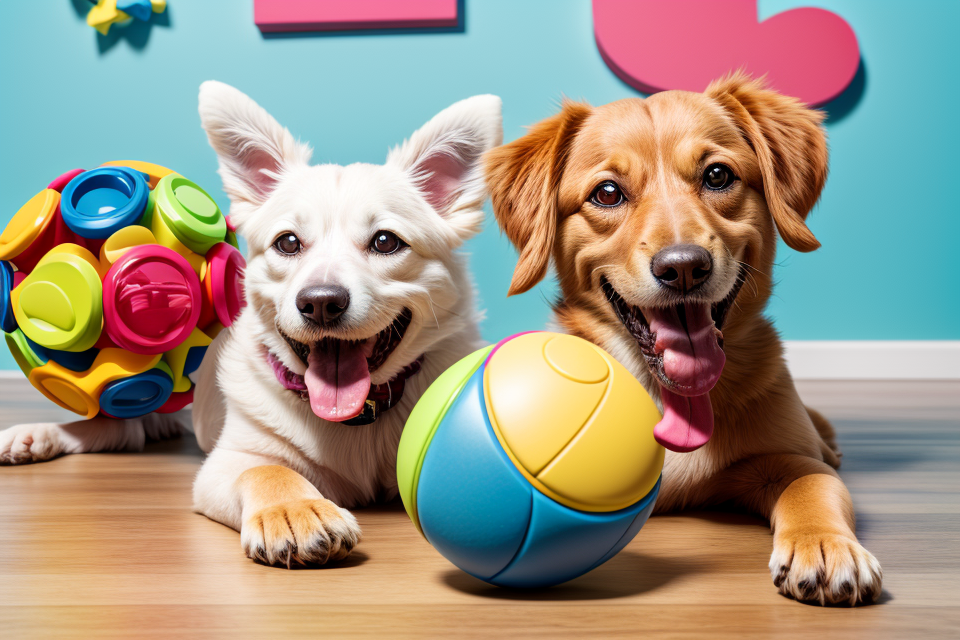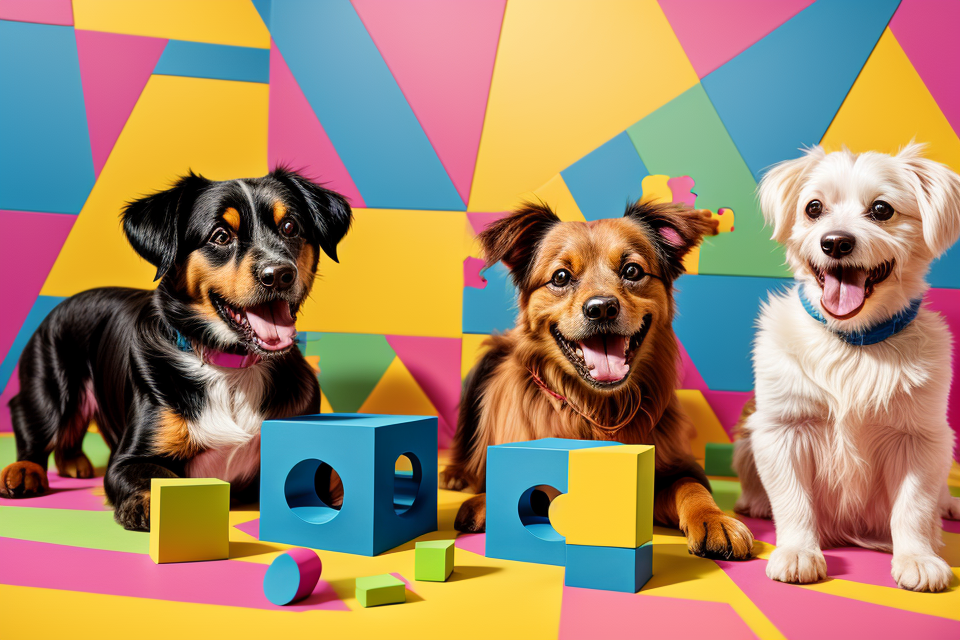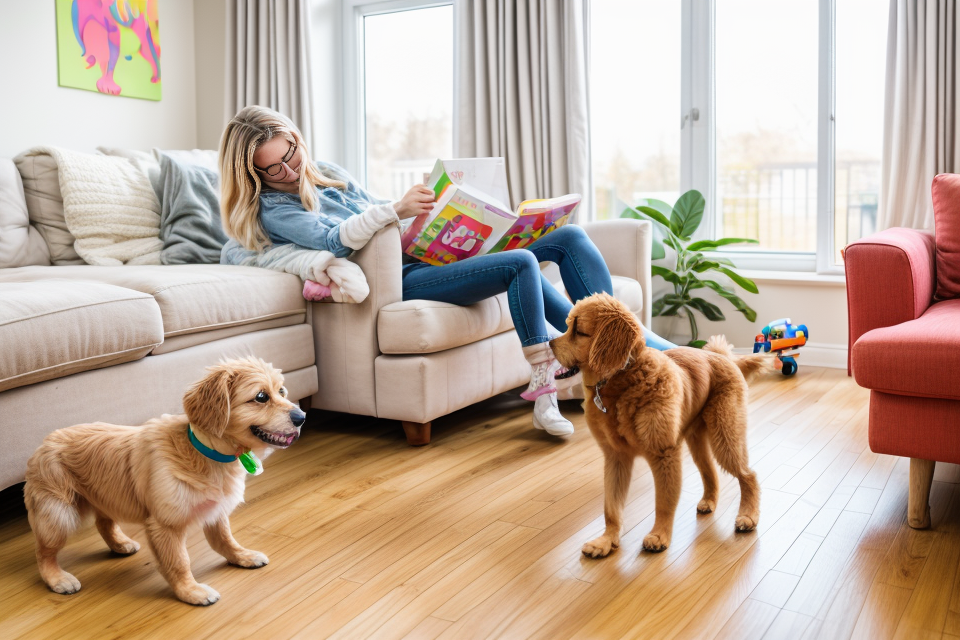Do you often find yourself wondering if puzzle toys are truly beneficial for your furry friend? As dog owners, we want to ensure that our pets are mentally stimulated and happy. Puzzle toys have become increasingly popular in recent years as a way to provide mental stimulation for dogs. But do they really live up to the hype? In this article, we will explore the benefits of puzzle toys for dogs and whether they are worth the investment. So, let’s dive in and find out if these toys can help keep your dog’s mind sharp and satisfied.
Puzzle toys for dogs have become increasingly popular in recent years, with many pet owners claiming that they provide a range of benefits for their furry friends. However, the scientific evidence supporting these claims is limited. While some studies suggest that puzzle toys can help improve dogs’ cognitive abilities and provide mental stimulation, others have found no significant benefits. It’s important to note that every dog is different and what works for one may not work for another. Ultimately, the decision to use puzzle toys for your dog should be based on your own observations and the specific needs and preferences of your pet.
What Are Puzzle Toys?
Definition and Purpose
Puzzle toys for dogs are interactive games or toys designed to challenge the dog’s cognitive abilities and problem-solving skills. These toys often require the dog to figure out how to access a treat or reward hidden inside, or to manipulate the toy in a specific way to reveal the reward.
The purpose of puzzle toys for dogs is to provide mental stimulation and exercise for their minds, similar to how physical exercise benefits their bodies. Puzzle toys can help prevent boredom and destructive behaviors, and may also help slow down the progression of cognitive decline in older dogs.
Additionally, puzzle toys can help satisfy a dog’s natural instinct to hunt and forage for food, as they must use their problem-solving skills to “uncover” the reward. This can be especially beneficial for dogs who are food-motivated and may have a tendency to beg or steal food from their owners.
Overall, puzzle toys can provide a fun and engaging way for dogs to exercise their minds and satisfy their natural instincts, while also strengthening the bond between the dog and their owner.
Types of Puzzle Toys
Analyzing Different Puzzle Toys
When it comes to puzzle toys for dogs, there are several different types available on the market. It’s important to understand the differences between these toys in order to determine which ones may be the most beneficial for your furry friend.
Interactive Puzzle Toys
Interactive puzzle toys are designed to challenge your dog’s mind and keep them engaged for longer periods of time. These toys often require your dog to figure out how to move objects around in order to reveal a hidden treat or toy. Some examples of interactive puzzle toys include:
- The “Nina Ottosson” toy, which features a series of hidden compartments that your dog must open by moving various objects around.
- The “Outward Hound” puzzle toy, which has a series of challenges that your dog must complete in order to reveal a hidden treat.
Food-Dispensing Puzzle Toys
Food-dispensing puzzle toys are designed to slow down your dog’s eating pace and encourage them to use their problem-solving skills. These toys typically have a number of compartments or sections that your dog must open in order to access the food inside. Some examples of food-dispensing puzzle toys include:
- The “Kong” puzzle toy, which has a series of small holes that your dog must push the food through in order to access it.
- The “PetQ” puzzle toy, which has a number of small compartments that your dog must open in order to access the food inside.
Hide-and-Seek Puzzle Toys
Hide-and-seek puzzle toys are designed to encourage your dog to use their sense of smell and encourage them to move around and search for hidden treats or toys. These toys often have a number of small compartments or cubbies that your dog must search through in order to find the hidden goodies. Some examples of hide-and-seek puzzle toys include:
- The “Snuffle Mat” toy, which has a series of raised ridges that your dog must sniff and dig through in order to find the hidden treats.
- The “Treat Dispenser” toy, which has a number of small compartments that your dog must search through in order to find the hidden treats.
Overall, the type of puzzle toy that may be best for your dog will depend on their individual needs and interests. By understanding the differences between these toys, you can make an informed decision about which ones may be the most beneficial for your furry friend.
Canine Cognition and Puzzle Toys
The Impact on Dogs’ Mental Abilities
Puzzle toys are designed to challenge dogs mentally, and research suggests that they can have a positive impact on dogs’ cognitive abilities.
Enhancing memory and problem-solving skills
Dogs have been shown to improve their memory and problem-solving skills when playing with puzzle toys. By requiring dogs to figure out how to access hidden treats or toys, puzzle toys encourage dogs to use their brains in new and creative ways.
Improving focus and attention
Puzzle toys can also help improve dogs’ focus and attention. Many dogs become easily distracted, but puzzle toys require them to concentrate and focus on the task at hand in order to succeed. This can help improve their overall attention span and ability to focus on commands and other important tasks.
Boosting self-esteem and confidence
Finally, puzzle toys can also boost dogs’ self-esteem and confidence. When dogs are able to solve a puzzle and access a reward, they experience a sense of accomplishment and pride. This can help build their confidence and encourage them to tackle other challenges and tasks.
Training with Puzzle Toys
Effective Training Techniques
Using puzzle toys for positive reinforcement
Positive reinforcement is a training technique that involves rewarding desired behaviors, rather than punishing undesired ones. Puzzle toys can be a powerful tool for positive reinforcement, as they provide dogs with a sense of accomplishment and pride when they figure out how to solve the toy. This type of reinforcement strengthens the dog’s motivation to engage in problem-solving and learning behaviors, and can lead to better behavior overall.
Motivating dogs to learn and improve
Puzzle toys can also be used to motivate dogs to learn and improve their problem-solving skills. By presenting dogs with increasingly difficult puzzles, owners can challenge their dogs to think critically and creatively, which can lead to better behavior and greater confidence. Additionally, puzzle toys can be used to teach dogs new commands or tricks, as they provide a fun and engaging way to reinforce desired behaviors.
Building a strong bond between dog and owner
Using puzzle toys during training sessions can also help build a strong bond between dog and owner. As dogs work to solve the puzzles, they will look to their owners for guidance and support, creating a stronger sense of trust and partnership. Additionally, puzzle toys can be used as a way for owners to spend quality time with their dogs, strengthening the bond between them.
Overall, using puzzle toys for training can be a highly effective technique for improving behavior and building a strong bond between dog and owner. By providing dogs with the opportunity to engage in problem-solving and learning behaviors, puzzle toys can help promote positive reinforcement, motivation, and trust between dogs and their owners.
Selecting the Right Puzzle Toy
Factors to Consider
When selecting a puzzle toy for your dog, it is important to consider several factors to ensure that the toy is appropriate and beneficial for your furry friend.
- Breed and size of the dog: Different breeds of dogs have different physical and mental characteristics, and this can affect their preferences and abilities when it comes to puzzle toys. For example, larger dogs may require more challenging puzzle toys to keep them entertained, while smaller dogs may be satisfied with simpler toys. It is important to select a puzzle toy that is appropriate for your dog’s breed and size to prevent frustration or boredom.
- Individual preferences and needs: Every dog is unique and has their own individual preferences and needs. Some dogs may prefer puzzle toys that involve food, while others may prefer toys that involve playing with a ball or other type of object. It is important to consider your dog’s individual preferences and needs when selecting a puzzle toy to ensure that they will enjoy playing with it.
- Durability and safety: Puzzle toys can be expensive, and it is important to select a toy that is durable and will last a long time. It is also important to consider the safety of the toy, especially if your dog is prone to chewing or destroying toys. Look for toys made with high-quality materials and designed with safety in mind to ensure that your dog can enjoy playing with the toy without any risks.
The Limitations of Puzzle Toys
Potential Drawbacks and Alternatives
Over-reliance on puzzle toys
While puzzle toys can provide mental stimulation for dogs, it is important to be mindful of the potential drawbacks. One of the main concerns is the risk of over-reliance on these toys, which may lead to dogs becoming less interested in other forms of play and interaction. This over-reliance could result in dogs becoming less socialized and less responsive to commands.
Ensuring a balanced approach to playtime
To prevent over-reliance on puzzle toys, it is essential to adopt a balanced approach to playtime. This means incorporating a variety of activities and toys that cater to different aspects of a dog’s well-being, such as physical exercise, socialization, and mental stimulation. Owners should rotate puzzle toys with other types of toys and activities, including fetch, tug-of-war, and scent work, to maintain their dog’s interest and prevent boredom.
Other ways to stimulate dogs mentally and physically
Apart from puzzle toys, there are numerous other ways to stimulate dogs mentally and physically. These include providing access to safe outdoor spaces for exploration and play, enrolling them in obedience classes or agility training, and engaging in interactive games such as hide-and-seek or scent work. Owners can also introduce new environments and experiences, such as taking a dog to a new park or visiting a pet-friendly store, to keep them mentally and physically stimulated.
By being aware of these potential drawbacks and alternatives, dog owners can ensure that their furry companions receive a well-rounded and engaging playtime experience that caters to their physical, mental, and social needs.
The Verdict on Puzzle Toys for Dogs
While puzzle toys can provide mental stimulation for dogs, it is important to note that they may not be the ultimate solution for meeting a dog’s cognitive needs. There are several limitations to consider when it comes to puzzle toys for dogs.
Firstly, puzzle toys may not be suitable for all dogs. Some dogs may become frustrated or bored with the toys, while others may be able to solve them too easily. It is important to consider the individual needs and abilities of each dog when selecting puzzle toys.
Secondly, puzzle toys may not provide the same level of mental stimulation as other forms of cognitive enrichment. While they can be a fun and engaging way to challenge dogs mentally, they may not be as effective as other forms of cognitive stimulation, such as training, playtime, and socialization.
Finally, it is important to remember that puzzle toys should not be used as a substitute for proper exercise and physical activity. While they can be a fun and engaging way to keep dogs mentally stimulated, they should not be relied upon as the sole source of exercise for a dog.
In conclusion, while puzzle toys can be a fun and engaging way to provide mental stimulation for dogs, it is important to consider their limitations and to provide a range of cognitive enrichment activities to meet the individual needs of each dog.
FAQs
1. What are puzzle toys for dogs?
Puzzle toys for dogs are interactive toys designed to challenge and stimulate a dog’s mind and body. These toys often require the dog to figure out how to access the treats or rewards hidden inside, providing mental and physical stimulation.
2. How do puzzle toys benefit dogs?
Puzzle toys can provide numerous benefits for dogs, including mental stimulation, physical exercise, and relief from boredom and separation anxiety. These toys can also help to prevent destructive behaviors and keep dogs mentally and physically fit.
3. Are puzzle toys appropriate for all dogs?
While most dogs can benefit from puzzle toys, it’s important to consider the individual needs and abilities of each dog. Some dogs may be more interested in and skilled at puzzle toys than others, and some dogs may require a higher level of difficulty to stay engaged. It’s important to start with easy puzzle toys and gradually increase the difficulty as the dog becomes more skilled.
4. How often should I give my dog puzzle toys?
It’s recommended to give dogs puzzle toys as often as possible, especially when they are home alone or need mental stimulation. Puzzle toys can be used as part of a regular routine or as a special treat to keep dogs engaged and interested.
5. What types of puzzle toys are available for dogs?
There are many different types of puzzle toys available for dogs, including treat dispensing toys, hide-and-seek toys, and interactive games. Some puzzle toys are designed for individual play, while others are meant to be played with by multiple dogs. The type of puzzle toy that is best for a particular dog will depend on their individual needs and interests.



